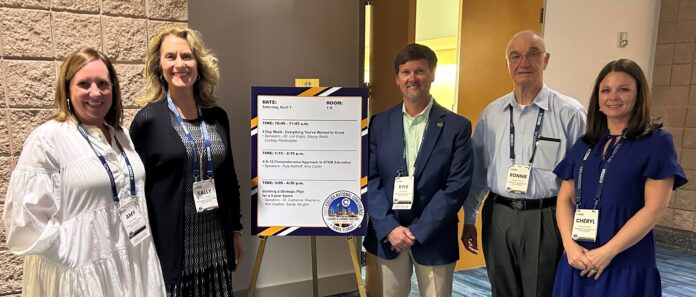
Cullman City Schools superintendent, school board teach STEM strategy at state level
Cullman City Schools has been leading the charge with an expansive, innovative approach to Science, Technology Engineering and Math (STEM) education at every level — and system leaders recently had a chance to share their approach and findings with school systems across the state of Alabama.
Board president Cheryl Harrison, board member Amy Carter and Superintendent Kyle Kallhoff presented the system’s approach to STEM at the Consortium of State School Boards Associations (COSSBA) last week, hosted in Tama, Fla. The session was titled “A K-12 Comprehensive Approach to STEM Education.”
“We shared some of the great work our teachers are doing from STEM exposure in the earlyadin grades, to exploratory in the upper elementary grades, to application at the middle and high school levels,” Kallhoff explained. “We highlighted our STEM team of educators from each school, the role of our technology integration specialists, and the supportive role the board takes in providing teachers with resources and opportunities to deliver STEM education.”
So what is Cullman City Schools’ STEM approach? The district created a system-wide STEM plan designed to immerse students in collaboration, problem-solving, reasoning, and higher-order thinking skills through STEM and Computer Science curricula at every level. The plan was developed by a STEM team comprised of teachers, instructional coaches, and district leaders tasked with creating a comprehensive plan to vertically integrate STEM and Computer Science across K-12 education. For example, in Cullman’s Career Technical Education programs, instructors embedded STEM competencies identified by industry and workforce development as critical competencies students must possess directly into the course of study.
Kallhoff, Harrison and Carter highlighted the work the STEM team did to infuse STEM and computer science competencies into the elementary school curriculum and how they aligned those practices with middle school and high school course offerings which include Health Sciences, STEM Technologies, Computer Science, Robotics, and future plans for Engineering.
STEM already plays a critical role in equipping learners with the foundational, transferable skills they will need for future jobs and the shifting work opportunities ahead. Cullman City Schools is working to help students develop 21st-century skills by exposing them to STEM at an early age and immersing them in STEM education and activities.
“The meaningful, hands-on educational experiences that STEM offers helps students pursue a career passion that was first fueled in the classroom,” Kallhoff said.

























